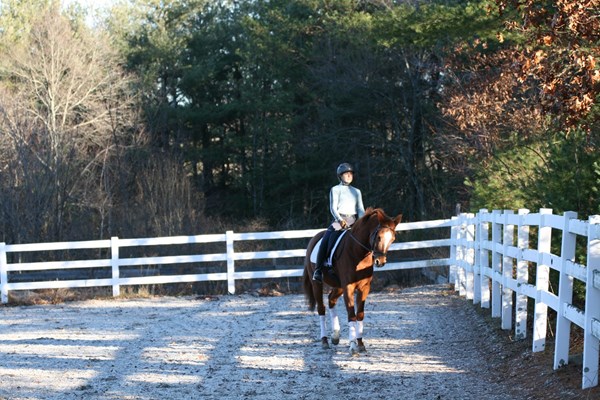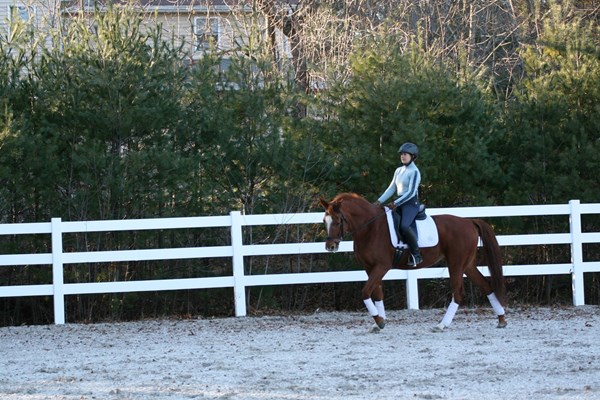The leg yield is an excellent tool that I use often with horses of all levels. This exercise helps horses become more flexible in the shoulders, back and hips. Also, riding leg yields develops the connection through the horse’s body from both the rider’s legs and seat bones to both reins.

What Is It?
The leg yield is an exercise done at the walk and trot. The horse should not have bend in the body as he moves sideways away from the direction of his flexion. The horse’s front and hind legs should cross in relation to the angle of the leg yield.
I remind students to feel an even contact on both reins during the leg yield. For an exercise that develops the connection, the horse’s neck and poll must be coming straight out of the shoulders. The priority in the leg yield is to first supple the body. Then I make sure there is correct and steady flexion in the poll away from the direction of movement.
There are good reasons to use the leg-yield exercise in your training, which include the following:
• The leg yield is a gymnastic exercise for the horse because his legs cross over one another to loosen the body. The muscles and joints warm up and stretch during the leg yield to help the horse become supple, which then allows him to relax, breathe and soften his back.
• The exercise allows you to feel the horse’s sides with your leg, which allows you to test and see if he is in front of your leg. Each day you must make sure both sides of the horse respond evenly to your leg aids. The leg yield helps you feel the horse’s reaction and fix any problems.
• You develop the connection because you move the horse’s inside hind leg to the outside rein. During and after the exercise, the goal is that the horse has an even connection on both sides from the seat and leg to the rein.
Aids
The leg yield along the wall is a good place to learn and perfect the aids for the leg yield. Begin with the horse at a regular rhythm and tempo in the medium walk to the right on the second track or slightly off the wall. Keep the horse’s neck straight on the long side and ask for slight left flexion.
Next, use the left leg and seat bone to ask the horse to bring his haunches in toward the center of the ring while his shoulders stay on the second track. He should walk at about a 30-degree angle along the wall. Feel your leg asking in the rhythm of the walk for each step, not just a constant squeeze. If the horse does not respond well to your leg, use a tickle of the spur or whip to send him sideways. Simultaneously, keep the contact even on both reins and use squeezes on the right rein to keep the horse’s body straight and to control the shoulder. Think of the left hind leg stepping into the right rein as you receive that connection. Make sure your body is straight and pointed toward the wall at the same angle as the horse’s chest. When you get to the corner and straighten the horse, keep the same receiving quality in the contact. I often use this exercise in the warm-up to loosen up my horse. Try it in the trot as well.
Advanced Exercise
Leg yield in and out on a 20-meter circle is more difficult, but it makes the horse even more supple and improves the connection. Once you and the horse understand the aids of leg yield along the wall, begin on an 18-meter circle at the medium walk or working trot tracking left. Because the circle is so big, the horse is only bent slightly to the inside. Use the aid for leg yield from the left leg and carefully push the horse out onto the 20-meter circle. On the 20-meter circle, straighten the horse and change the flexion to the right. Leg yield in from the right leg back onto the 18-meter circle. Do not focus on leg yielding in or out quickly or steeply. Instead, make sure you ask yourself these questions:
• Does my horse maintain rhythm, regularity and balance during the exercise?
• Do I maintain my balance in the saddle?
• Am I always in control of my horse’s hips and shoulders?
• Is the change of flexion smooth?
• Do I feel an improvement in the quality of the connection?

Try the exercise in both directions. Use the feeling from the exercise to supple and connect the horse on any line or figure where he loses lateral balance. In other words, if you feel him falling in during the corner, you can use the leg yield to push him out and keep him connected on the outside rein. Or if he falls out through the shoulder during a circle, you can use the outside rein and leg as if to leg yield, but you, in fact, just control the outside of his body.
Incorporate the leg yield into your daily routine and reap the benefits of a more supple and better connected ride.
Sven Dapper’s career began as a Young Rider in the German Young Rider Championships. He finished his school years by passing the professional rider’s exams with the highest possible honors. He has his rider’s gold medal and now operates Hof Börnsen, a training and sales stable near Hamburg, Germany, with Judy Allmeling.











